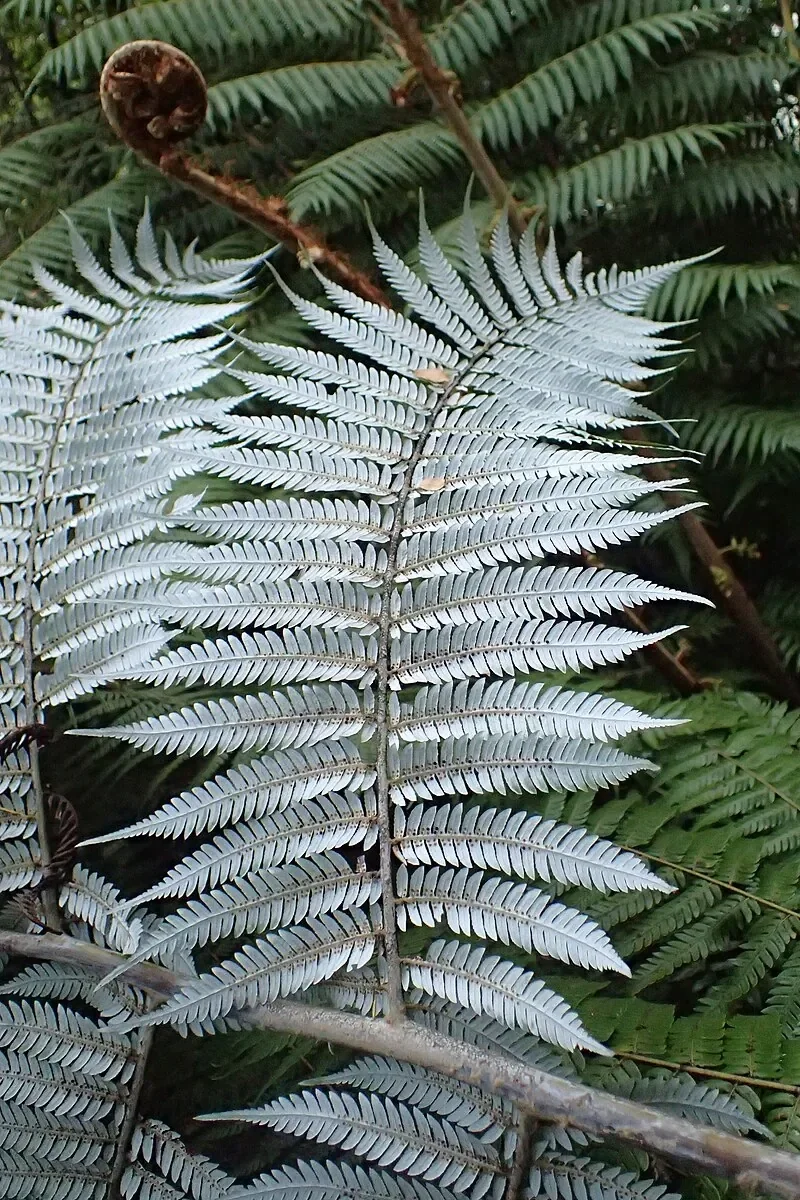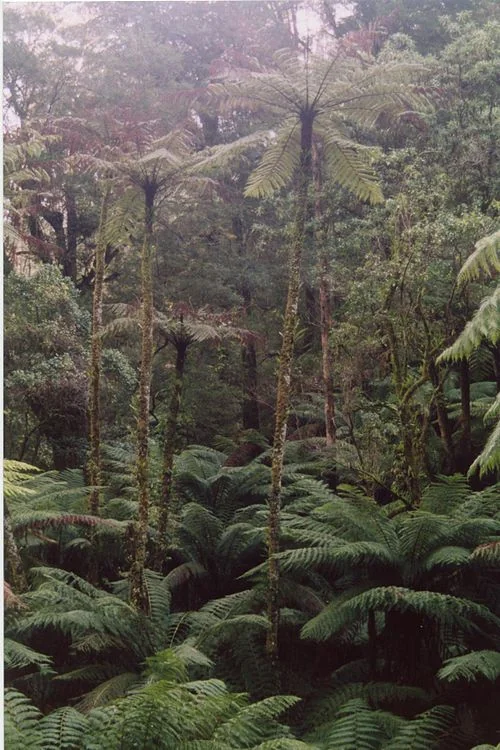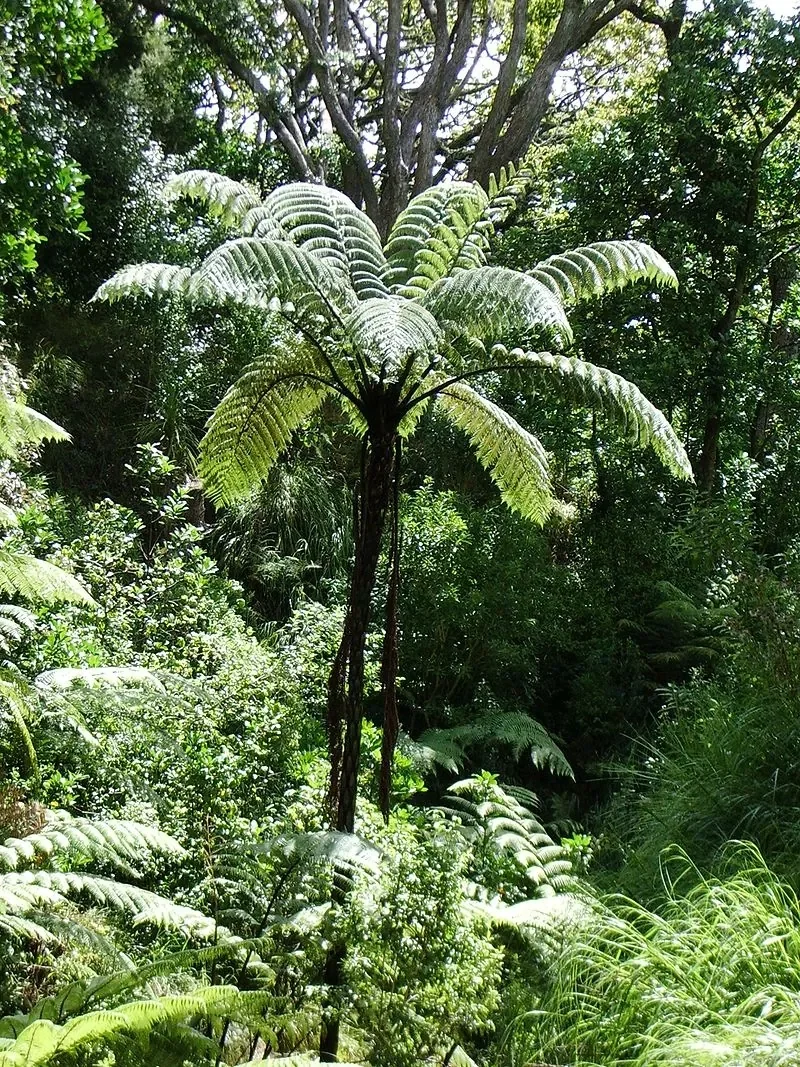
Silver Fern
Cyathea dealbata
Introduction
Introduction Overview
Silver Fern ( Cyathea dealbata ) is an iconic New Zealand tree fern, easily recognized by the silvery-white undersides of its fronds. It is a symbol of New Zealand-s natural heritage and is widely used in landscaping and as a national emblem. You can find more information about various native plants on our homepage . Learn more about New Zealand ferns .

Plant Description
Botanical Features
Cyathea dealbata , commonly known as the Silver Fern or Ponga, is an iconic evergreen tree fern native to New Zealand. It is easily recognized by its distinctive fronds, which are bright green on the upper surface and a striking silver-white underneath. This slow-growing fern can reach heights of up to 9 to 12 meters with a trunk diameter of 160-450 mm, covered in light brown or white projecting stipe bases. Its fronds can be very large, sometimes up to 4 meters long, forming a full, dense crown. It typically grows as a sub-canopy species in various forest types, including kauri, podocarp, beech, and broadleaved forests, as well as in kānuka and mānuka scrub, often in drier areas. It prefers moist, sheltered conditions with humus-rich soil and shade from strong sun, though it can tolerate full sun and dry conditions once established.
Quick Facts
Quick Facts Overview
| Scientific Name | Cyathea Dealbata |
|---|---|
| Height | Up to 10 m (trunk); fronds up to 4 m long |
| Spread | 2-4 m (crown diameter) |
| Water Needs | High; prefers consistently moist soil |
| Light | Partial shade to dappled sunlight |
| Frost Tolerance | Moderate (tolerates light frost, protect from severe frost) |
| Salt Tolerance | Low to moderate (not suited to exposed coastal sites) |
| Growth Rate | Moderate |
| Lifespan | Long-lived (decades to over 100 years) |
Climate Best Suited to
Prefers mild , humid climates with regular rainfall. Common in lowland and coastal forests throughout New Zealand.
Regional Suitability
Widespread in the North and South Islands, especially in moist, sheltered sites.
| City | Suitability |
|---|---|
| Whangārei | Ideal |
| Auckland | Ideal |
| Hamilton | Ideal |
| Tauranga | Ideal |
| Rotorua | Ideal |
| Gisborne | Ideal |
| New Plymouth | Ideal |
| Napier | Ideal |
| Whanganui | Ideal |
| Palmerston North | Ideal |
| Wellington | Ideal |
| Nelson | Ideal |
| Christchurch | Ideal |
| Dunedin | Ideal |
| Invercargill | Ideal |
Natural Habitat
Natural Habitat Overview
Cyathea is naturally found in specific habitats throughout New Zealand. Understanding its natural environment helps in providing appropriate growing conditions in cultivation.
Plant Conservation
The silver fern, Cyathea dealbata (also known as Alsophila dealbata), is classified as "Not Threatened" under the New Zealand Threat Classification System (NZ TCS). It is a common and widespread species throughout most of its range in New Zealand, found in both the North and South Islands.
While generally not threatened, the species can be sensitive to forest clearance and habitat disturbance. It thrives in moist, well-draining soil in partial shade to dappled sunlight, and is often found in lowland and coastal forests. The silver fern is an iconic symbol of New Zealand and plays an important ecological role by providing habitat and food for native wildlife.
Soil
Moist, well-draining, rich in organic matter.
Light
Partial shade to dappled sunlight.
Water
Consistent moisture , especially when young.
Ferns prefer consistent moisture and protection from strong winds. They thrive in organic-rich, well-draining soils.
Planting Guide
When to Plant
The best time to plant Cyathea is during spring or autumn when soil temperatures are moderate and rainfall is reliable.
How to Plant
Dig a hole twice the width of the root ball and slightly deeper. Place Cyathea in the hole, backfill with soil, and water thoroughly. Mulch around the base to retain moisture.
Ecological Role
Wildlife Interactions
Cyathea plays an important ecological role in New Zealand's native ecosystems. It provides habitat and food for native wildlife and contributes to ecosystem health and biodiversity.
Uses and Significance
Garden Uses
- Iconic feature plant for native gardens
- Excellent for shaded, moist areas
- Provides shelter and habitat for native wildlife
Landscaping Uses
Landscaping Uses Overview
Cyathea is highly valued in landscaping for its aesthetic appeal and practical benefits. It can be used in various garden styles and landscape applications.
Seasonal Care Calendar
Spring
New fronds unfurl; keep soil moist and mulch around base.
Summer
Water during dry spells; protect from harsh sun.
Autumn
Remove old fronds; check for pests.
Winter
Minimal care needed; protect young plants from frost.
Pruning
Pruning Techniques
Remove dead or damaged fronds as needed. Avoid cutting the growing tip.
Regular pruning of Cyathea helps maintain its health and desired shape. Remove any dead, diseased, or crossing branches to improve air circulation and reduce the risk of pest and disease problems.
For most native plants, light pruning throughout the growing season is better than heavy pruning at once. This approach encourages healthy new growth while maintaining the plant's natural form and character.
How to Grow Silver Fern
The Silver Fern is an iconic and beautiful native tree fern, instantly recognizable by the distinctive silvery-white undersides of its fronds. It is a symbol of New Zealand's natural heritage and is widely used in landscaping and as a national emblem. While it is a magnificent plant, successful cultivation requires attention to its specific needs, particularly regarding moisture, shade, and protection from frost. It thrives in conditions that mimic its natural forest habitat, making it an excellent choice for shaded, moist gardens.
From Spores
Propagating Silver Fern from spores is a rewarding but challenging process that requires patience and specific conditions. Collect mature spores from the undersides of healthy fronds when they are dark brown and easily dislodge. Sow the spores onto a sterile, moist substrate, such as peat or a specialized fern-growing medium, in a sealed container to maintain high humidity. Keep the container in a warm, dimly lit location. Germination can take several weeks to months, forming a green, moss-like prothallus. Eventually, tiny fern sporophytes will emerge. Once they are large enough to handle, transplant them into individual pots and gradually acclimate them to lower humidity before planting out.
From Nursery-Grown Plants
For most gardeners, purchasing nursery-grown plants is the most practical and successful method for cultivating Silver Fern. Ensure you source plants from reputable native plant nurseries that specialize in ferns. When transplanting, minimize root disturbance and plant into a well-prepared site that meets all its environmental requirements: partial shade to dappled sunlight, consistently moist but well-drained, humus-rich soil, and protection from strong winds and severe frost. Regular watering, especially during dry periods, and occasional misting of the fronds will be essential for the plant's establishment and long-term health.
Pests and Diseases
Common Pests
Cyathea is generally resistant to most pests due to its native adaptations. However, it may occasionally be affected by common garden pests such as aphids or scale insects.
Disease Prevention
To prevent diseases, ensure good air circulation around Cyathea and avoid overwatering. Remove any diseased plant material promptly to prevent spread.
Cultural Significance
The Cyathea dealbata , commonly known as the silver fern or ponga, holds profound cultural significance, particularly in New Zealand. It is an iconic national emblem, recognized both within the country and internationally.
Within Mātauranga Māori (Māori Knowledge and Culture):
- The silver fern has deep cultural and ecological value. It contributes to the health of the ngahere (forest) and local ecosystems.
- According to Māori legend, the silver fern once resided in the sea and was called to the forest to guide the Māori people.
- Hunters and warriors utilized the silvery-white undersides of its fronds to mark paths at night, as they would reflect moonlight, illuminating a way through the forest.
- The koru symbol, which depicts the unfurling frond of the silver fern, is a prominent motif in Māori art, including carvings, marae, and tā moko. To Māori, the elegant form of the fronds symbolizes strength, stubborn resistance, and enduring power, and it also represents new life and new beginnings.
- Historically, ponga trunks were used for construction, foliage for bedding, sap for medicinal purposes, and its spikes for small bird spears.
In Modern New Zealand:
- The silver fern continues to be a powerful symbol. It has been associated with the national rugby team, the All Blacks, since the 1880s, and is proudly worn by many of the country's top athletes.
- Other national sports teams, such as the "Silver Ferns" (netball) and "Black Ferns" (women's rugby), also incorporate the fern into their names or emblems.
- Tourism New Zealand and New Zealand Trade and Enterprise have adopted it as a country-of-origin symbol.
- Its historical significance extends to military use, having been an emblem during the Boer War in 1899 and used by New Zealand troops in both World Wars, where it was painted on "fernleaf clubs" and adorns the headstones of war dead.
- For many New Zealanders, it symbolizes their deep attachment to their homeland.
Bonus Tip
Expert Growing Advice
Beyond its stunning beauty, the Silver Fern ( Cyathea dealbata ) holds a fascinating historical use by Māori. The distinctive silvery-white underside of its fronds was traditionally used to mark forest trails at night. As Māori navigated through dense bush, they would bend and break the fronds, leaving the reflective silver underside facing upwards. This allowed the moonlight to catch the silver, creating a visible path through the darkness. This ingenious method highlights the deep connection and understanding Māori had with their natural environment, turning a unique botanical feature into a practical tool for navigation.







